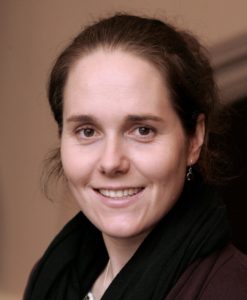By Sharon Adarlo
Claire White, an assistant professor of civil and environmental engineering and the Andlinger Center for Energy and the Environment at Princeton University, received a five-year CAREER grant from the National Science Foundation (NSF) to investigate more sustainable and resilient alternatives to Portland cement, a fundamental constituent in concrete and whose production emits one ton of carbon dioxide for every ton produced, accounting for five to eight percent of global carbon-dioxide emissions.
The NSF supports junior faculty members, such as White, “who exemplify the role of teacher-scholars through outstanding research, excellent education, and the integration of education and research within the context of the mission of their organizations,” through their Faculty Early Career Develop ment Program, according to the NSF website.
ment Program, according to the NSF website.
With this grant, White and her research group will look at the long term durability of alternative cement binders made from blast furnace slag (also known as alkali-activated slag), a glass-like material that is a byproduct of steel production. Blast furnace slag is already recycled for use in concrete in order to reduce the amount of Portland cement powder used, but it can replace all the Portland cement needed in a batch of concrete via a chemical activation process, further reducing greenhouse emissions.
Both Portland cement binder and alkali-activated slag binder have been shown to be equally strong, but the slag binder’s long term durability has not yet been fully determined – including when exposed to atmospheric carbon dioxide. The slag binder degrades in the presence of carbon dioxide in a process known as carbonation. This grant will allow White to investigate multiple types of alkali-activated slag, discover which among them is more resistant to carbonation, and understand the underlying chemistries of the materials.
“This research is so important because making Portland cement powder is detrimental to the environment. A significant amount of carbon dioxide is released into the atmosphere as a result of mining, producing, and transporting the material,” she said. “Finding durable alternatives will be crucial in order to make a large dent in reducing the amount of greenhouse gases we are releasing into the atmosphere.”
Being a byproduct of steel production, the properties of the slag, White explains, depend much on the mineral composition of iron ore that was used and the specific conditions used during the production of cast iron, which is a part of the steel manufacturing process.
“We get slag from different locations: New Jersey, Canada, and overseas,” she said. “It’s important to look at slag from different countries or plants because the material’s properties differ from one place to another.”
Before securing the grant, White and her team had already done preliminary work that found some alkali-activated slags to be more resistant to carbonation than other types of alkali-activated slag. This previous research was funded by a grant from Princeton E-ffiliates Partnership, a corporate affiliates program administered by the Andlinger Center.
“We really want to understand why certain slags work better than others in these alkali-activated cements. And then we want to exploit the processes on why this good slag works, so we can tailor the materials to be even more resistant to carbon dioxide,” she said.
For the study, White and her team plan to visit Argonne National Laboratory, just outside Chicago, in order to use the facility’s high-end synchrotron, a special piece of equipment, to perform experiments. The synchrotron experiments will enable the team to track in high resolution the structural changes of the alkali-activated slag binder as it undergoes carbonation in real time – a process they can’t measure on campus.
“It is crucial to determine what changes happen to the fundamental atomic structures,” White said about carbonation. “We need to apply state-of-art techniques to these materials in order to figure out the fundamental mechanisms that occur during exposure to carbon dioxide.”
Though the grant only covers alkali-activated slag, White’s investigations may yield insight into other alternatives to Portland cement, such as fly ash, a coal burning byproduct, and ash derived from municipal solid-waste incineration.
“Slag-based alkali-activated concrete is just one solution to reduce carbon dioxide in the environment due to concrete production,” she said. “Once we understand what’s going on in slag systems, we can look at other waste byproducts that could be just as useful as slag.”
As part of the grant, White will also put together an educational component for teachers who want to incorporate engineering into their curriculum. White said she will put together lesson plans and teaching modules on how cement and related construction materials are used in a variety of engineering applications, and how engineers are critical for solving climate change.
“Educating the next generation of engineers and scientists is so important,” she said. “I am glad I am part of this effort.”
White earned bachelor degrees in civil engineering and physics from the University of Melbourne, Australia in 2006. She then earned her doctorate in chemical engineering from Melbourne as well in 2010. She joined the Andlinger Center in 2013 and is also an associate faculty member in the Department of Chemical and Biological Engineering and the Princeton Institute for the Science and Technology of Materials (PRISM). She was previously a Director’s postdoctoral fellow at the Los Alamos National Laboratory in Los Alamos, New Mexico.
The mission of the Andlinger Center for Energy and the Environment (ACEE) is to develop solutions to ensure our energy and environmental future. To this end, the center supports a vibrant and expanding program of research and teaching in the areas of sustainable energy-technology development, energy efficiency, and environmental protection and remediation. A chief goal of the center is to translate fundamental knowledge into practical solutions that enable sustainable energy production and the protection of the environment and global climate from energy-related anthropogenic change.